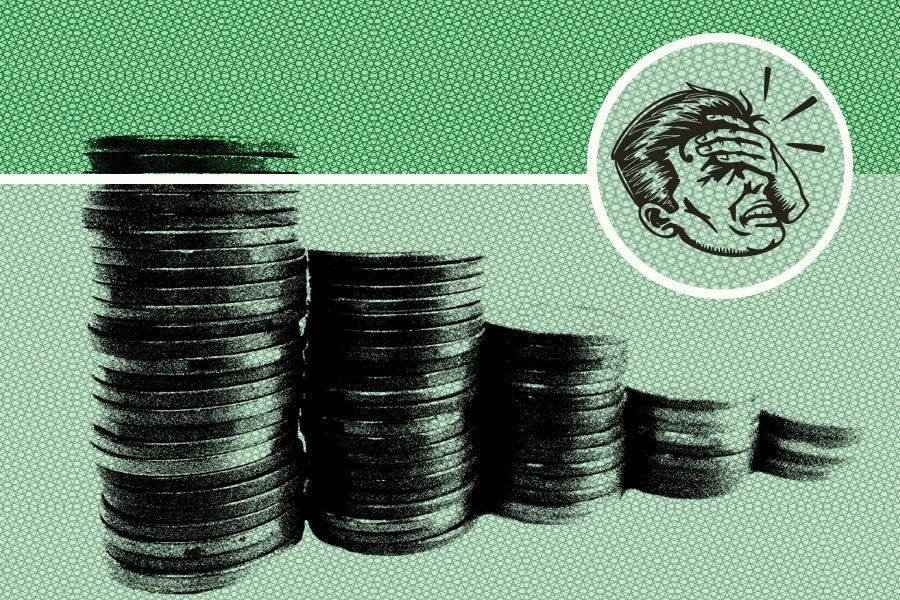Remember when you were a kid, and a savings account — and more importantly, the idea that you could get more money just by leaving your money in there — sounded awesome? Welp, those days are done, my friend. Rates on savings accounts these days are 0.01 to 0.05 percent. That’s an extra $0.10 to $0.50 a year on a $1,000 balance.
Don’t spend those earnings all at once!
But why? What happened to the times when interest rates actually meant more than a few extra cents?
Let’s try to figure out this banking bullshit.
Why isn’t my money growing these days?
Your money grows as much as the bank’s current interest rate allows it to (a bank’s interest rate, FYI, is the amount of money you earn every year for depositing funds with the bank).
When you put your money into your savings account, the bank immediately turns around and loans out that money to business owners, mortgage borrowers, etc. and charges them interest on it. This is how banks make money. Another thing banks do with your hard-earned savings is directly invest it themselves, often into very safe things like U.S. Treasury bills, which are basically a short-term loan to the government that pays interest, and which anyone can buy.
The problem comes from the fact that the interest rate on a one-month U.S. Treasury bill is less than half a percent right now, which means the bank isn’t making much money from it. And if they’re not making much themselves, they’re not going to pay you anything close to a half a percent on your money. They’ve got overheads, man!
So why do interest rates go up and down?
Let’s step back and look at the big picture, because this is very much a big-picture issue. “Just like anything else in economics, it’s all about supply and demand,” says Tim Trombley, a finance professor at San Diego State University. “Right now there’s a lot of supply [i.e., lots of people putting money in the bank] and not much demand for returns on those sorts of investments.”
Why is there so much supply right now? Two reasons, says Trombley. Reason number one: “Let’s say you’re a wealthy person living in [the developing world] and you want to make a safe investment. The best place in the world to put your money is in the U.S. If you want to make a risky investment, you make it in your own country.” In other words, there’s so much investment in U.S. banks right now that they won’t pay you as much for your money as they used to, because they don’t have to.
Reason number two: Inflation (the rate at which the cost of things increases) is very low right now. Back in the early 1980s, the inflation rate was 10 to 11 percent per year. Mortgages were loaned out at 20 percent interest rates or higher — it was a mess. Nowadays, inflation is around 2 percent, which is a lot more comfortable.
So, uhh, what does inflation have to do with all of this again?
Inflation is something that the Federal Reserve (our country’s central bank) keeps a close eye on and wants to keep under control. Now, inflation is a natural byproduct of a healthy economy, but high inflation leads to economic crashes like in the late 1970s and early 1980s (while hyperinflation causes all kinds of chaos — think of Germany’s Weimar Republic, which ended up leading the world into World War II). The Federal Reserve pulls a variety of monetary-policy levers to try and keep the rate of inflation in check — the trick is to manage inflation without pulling so many strings that it disrupts a healthy economy.
In a sluggish economy, like the one we’ve been experiencing for most of the past decade, the Federal Reserve will use those same levers to jump-start the economy. One of the things they can do is lower the federal funds rate, which is a benchmark rate at which the government will loan money to banks (this is the rate you often hear about in the news). People watch it closely because it influences banks’ own interest rates for savings accounts, loans, etc. The federal funds rate has been low for a while (more on that in a bit): Traditionally, the Fed raises it in a healthy economy as a way of tapping the brakes, and lowers it in a bad economy to encourage more lending and borrowing.
So why’s it been so low?
Get your “Thanks, Obama!” memes ready: The recent Great Recession was an enormous shock to the system, and in order to encourage growth, the Fed kept interest rates super low throughout Obama’s presidency to encourage borrowing (in other words, encouraging people to buy homes, start businesses and other things that would move the gears of the economy).
While this helped defibrillate a flatlining economy, growth was still painfully slow following the Great Recession. According to Trombley, this is due to the uncertainty Obama’s policies created in all sorts of markets: The energy sector, to pick one example, was scared of big shifts away from traditionally stable things like coal, and the possible introduction of radical new things like a carbon cap-and-trade program.
“As a general rule, the more policy uncertainty there is, the lower the economic growth,” Trombley says. “[In fact], There’s been more and more recent research that shows the biggest detriments to growth in the economy is policy uncertainty.” This is because it makes the big players in a sector hesitant to invest or spend money — which, of course, are the building blocks of a healthy economy.
In any case, during Obama’s presidency, the Federal Reserve pulled all the levers it could to revive the economy, which included lowering interest rates. Since banks closely follow the Fed’s rate, they followed with miniscule interest rates themselves.
Connect the dots for me: How are banks’ interest rates tied to the federal funds rate?
As we learned above, that federal fund rate is technically the interest rate at which banks can borrow money from the government (their lender of last resort, you might say). It also sets the rate at which banks can loan money to each other. It’s seen as a bargain-basement level of a rate to lend to companies and people, kind of like the baseline price of doing business.
Once banks have this number, they factor in their own expenses and a profit margin, plus see what their competition (other banks) is offering. That’s how they settle on an interest rate, and that’s why it’s so damn low these days. Because as the Fed goes, so go the banks. And the Fed rate has been low for a while.
In a nutshell, a bank’s interest rates are a result of three very big, complicated forces: The economy itself; political economic policy; and the government’s attempts to keep the economy healthy.
Will interest rates ever go back up, then?
Absolutely, says Trombley. “The Fed has raised interest rates several times this past year, they’re predicted to raise it several times again this coming year, and if you look at what the markets are predicting, the interest rates will continue to rise over the next few years,” he says. However, when it comes to banks’ rates, “There’ll probably be some delay there because banks aren’t exactly going to be hopping over themselves to pay more for your money. The only reason they’re going to do so is if they’re forced to by competition,” he says. That’s competition not only from other banks, but other forms of investment.
Is there somewhere else I can put my money that’s both safe and gives me a better return?
There are alternatives to savings accounts that are more responsive to interest rates, says Trombley. “For example, a certificate of deposit, known as a CD. It’s where you give the bank money and there’s a time limit on it where you can’t access the funds for that amount of time. So if you get a six-month CD, that means in six months you can come back and be able to access these funds. From the bank’s perspective, your money is guaranteed to be there for them. That guarantee is worth something for them, so if you’re willing to lock up your money for several months or a year or more, the bank will give you a higher rate of interest on it.” But it’s still not much — a 1-year, $2,500 CD at Wells Fargo has an annual yield of 0.05 percent.
The (even bigger) downside is, if you need the money — if you get fired tomorrow or your car breaks down, say — you have to wait to get it. “It’s not possible to withdraw early. You sign a contract with them,” Trombley says. “And since they have it, they’re not gonna have any incentive to break that contract.”
So basically, just wait a while, or put my money elsewhere?
That’s pretty much right. Savings account interest rates won’t get anywhere close to meaningful in the near future — those rates of between 5 and 10 percent in the 1980s and 1990s are long gone for now. So if you’d rather put your money somewhere else, now’s a good time.

